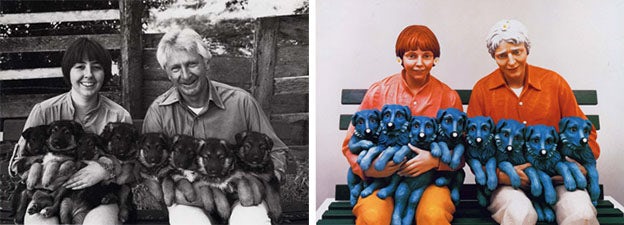Case Study 1 : Rogers v. Koons

Photograph: Art Rogers – 1985; Polychrome: Jeff Koons – 1988 (both via The Design Observer Group)
About the Case
This case is about Photographer Art Rogers shot a photograph of a couple (Jim Scanlon and his wife ) holding a line of puppies in a row and sold it for use in greeting cards and similar products. Internationally, the famous artist Jeff Koons in the process of creating an exhibit on the banality of everyday items, ran across Rodgers’ photograph and used it to create a set of statues based on the image. Jeff Koons asked his assistants to copy as much detail as possible from the photographs. The only changes made during the transition were larger noses on the puppies, blue fur, and the man and woman had flowers in their hair. The sculpture was named "String of Puppies" and became a success. Reportedly, Koons sold three of the sculptures for $367,000.
Jeff Koons sold several of these structures, making a significant profit. Upon discovering the copy, Rodgers sued Koons for copyright. Koons responded by claiming fair use by parody.
Held
The court found the similarities between the 2 images too close, it is easy to be able to recognize the copy. Koon’s defense was rejected under the argument that he could have used a more generic source to make the same statement — without copying Rogers’ work. Koons was forced to pay a monetary settlement to Rodgers.
Copyright Act 1987 Section 36(1)
The Copyright Act 1987 states that an infringement occurs when a person does something without the licence or permission or consent of the copyright owner.
The copyright in a work is infringed when a person who:
(i)not being the owner of the copyright
(ii)without consent or license of the owner of the copyright,
Point of view
Based on the case above,(Rodgers vs koons) had involve in Copyright act 1997 because Koon sold several of Rodgers photograph artwork and making a significant profit. In the case of Koon being sued by Rodger for violating his copyrights on his photographs, it was evidently found that the similarities between both photographs were too close. Consequently, Koon was given the penalty to pay a settlement to Rodger. This case reminds us to be as original as possible when publishing, creating or printing our works. This is due to the fact that copyright infringement is a violation of the copyright laws for which a person will be sued for taking others' works or ideas without giving a proper credit to the owners. It is a serious offence in most of our daily life when producing a work, either in schools or workplace, such as artworks, assignments, academic projects, research and so on. As much as we know ideas are everywhere and they do not being produced for free. Time, efforts, money and other sacrifices were done to create works that are original. It would be unfair and unethical for someone else to take the ideas without permission. Apart from causing unfairness, it also shows how unprofessional you are in doing a task. As a result, you may be labelled as underperformed employee in a company because you did not actually make significant contribution for the particular project given. In addition, everyone has their own talents and the works which they have been producing act as a platform to show it to the world. The originality, potential, efforts, and creativity are all in it that others do not deserve it effortlessly. Therefore, it is advisable that all of us give proper credits to the owner or innovate something by using the ideas instead of copying it directly. Eventually, it enables the country to create peace among the society as we respect each other.
http://www.casesofinterest.com/tiki/Rogers+v+Koons
https://en.wikipedia.org/wiki/Rogers_v._Koons
https://cpyrightvisualarts.wordpress.com/2011/12/20/art-rogers-vs-jeff-koons/
Comments
Post a Comment